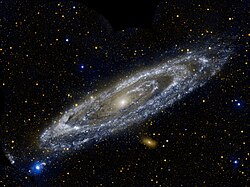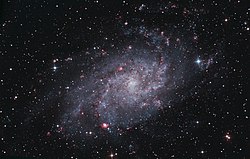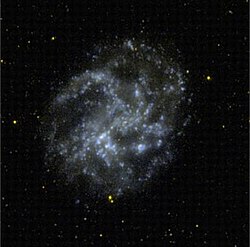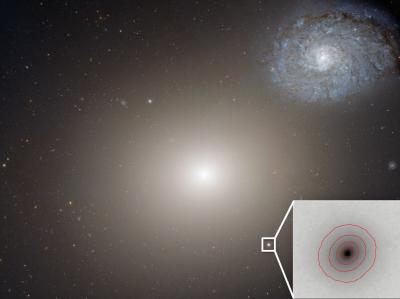heehaw wrote:bystander wrote:heehaw wrote:Do I recall arightly that M33 is a dwarf galaxy? (M31 is like our own galaxy, a big one.)
No,
M33 is thought to be over 60,000 light years in diameter, contain more than 40 billion stars, and have a complement of dwarf companions. I think it qualifies as a full fledged spiral galaxy.
Yes! But I have checked a bit further, and my memory has been jogged. Wikipedia gives the mass of M31 as 1230 billion solar masses, and that of M33 as only 50 billion solar masses, so M31 is 25 times more massive. A big number! What impresses me is that even with this huge mass difference, one gets in both cases a perfectly conventional spiral galaxy. The processes that produce the spiral effect seem to be independent of what size the eddy is (they sure look like eddies, anyway!)
Infrared image of M31 by WISE.
Blue means stars, red means dust.

Ultraviolet image of M31 by GALEX.
Blue means hot stars, yellow means cool stars.
M31 is a big galaxy, bigger than we think.
Wikipedia wrote:
Mass estimates for the Andromeda Galaxy's halo (including dark matter) give a value of approximately 1.5×10
12 M
☉[7] (or 1.5 trillion solar masses) compared to 8×10
11 M
☉ for the Milky Way...
The total stellar mass of Andromeda is estimated to be between 1.1×10
11 M
☉.,[40][41] (i.e., around twice as massive as that of the Milky Way)...
Studies made with the help of the Hubble Space Telescope and published in 2015, have uncovered a large and massive halo of hot gas enveloping M31. This halo is estimated to contain half the mass of the stars in the Andromeda galaxy itself. As of May 7, 2015, the halo is about six times larger and 1,000 times more massive than previously measured...
M31 appears to have significantly more common stars than the Milky Way, seeming to predominate the old stars with ages >7×10
9 years,[42][clarification needed] and the estimated luminosity of M31, ~2.6×10
10 L
☉, is about 25% higher than that of our own galaxy.[50]

M33. Photo: Alexander Meleg.
NGC 7331, a bluer and dustier galaxy than M31.
Note the obvious spiral arms.
Photo: Vicent Peris/ Calar Alto Observatory
Wikipedia points out that it is hard to know exactly how luminous M31 really is, due to its high inclination and dust absorption. In my opinion, M31 doesn't appear to be very dusty. Its far infrared ("dust") magnitude is 1.3 magnitudes
fainter than its B magnitude, whereas, for example, NGC 7331, which is somewhat similarly in appearance and inclination to M31, is 1.3 magnitudes
brighter in far infrared than in blue light.
There are also suggestions that M31 is a ring galaxy rather than a spiral galaxy, but most astronomers seem to agree that M31 is a spiral galaxy of Hubble type Sb.
Andromeda also has a very massive central black hole. Check out
this list of the most massive black holes known. The supermassive central black hole of M31 is relatively far down that list, but at least it
makes the list. Most Messier and NGC galaxies don't.
All in all, the large size, huge star populations, enormous halo, massive black hole, red colors and comparatively small dust content all suggest to me that M31 is a huge galaxy indeed.
M33, by contrast, has a definite spiral shape, but its arms are flimsy and irregular, and its bulge is faint. Its colors are blue, and its far infrared magnitude is only 0.1 mag fainter than its B magnitude, so M33 is (relatively speaking) dustier than M31. The size of M33, while not remarkably small, is clearly smaller than the sizes of both Andromeda and the Milky Way. And M33 contains only a small central black hole, if there is a black hole there at all.
All in all, and since there are no suggestions that M33 contains a whoppingly large halo, it is clear that relatively lightweight, whereas M31 is a Mike Tyson of galaxies.
Ann
 M33: Triangulum Galaxy
M33: Triangulum Galaxy


